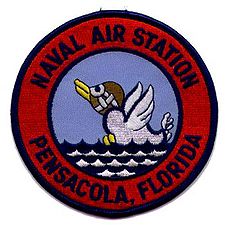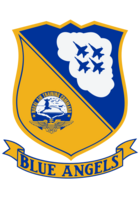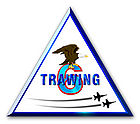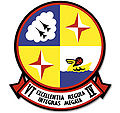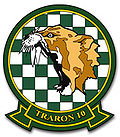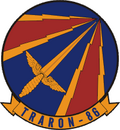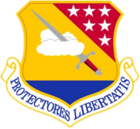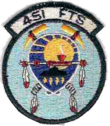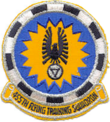Difference between revisions of "Pensacola Naval Air Station (NPA) Escambia County (FL)"
From The RadioReference Wiki
| Line 19: | Line 19: | ||
Currently, we have 10 T-39 "Sabreliners", 42 T-6A "Texan II", and 12 T-45 "Goshawks" in our inventory. Our instructor cadre includes Navy and Marine instructor pilots, Naval Flight Officers (NFO), and Weapon Systems Officers (WSO), as well as international flight instructors. | Currently, we have 10 T-39 "Sabreliners", 42 T-6A "Texan II", and 12 T-45 "Goshawks" in our inventory. Our instructor cadre includes Navy and Marine instructor pilots, Naval Flight Officers (NFO), and Weapon Systems Officers (WSO), as well as international flight instructors. | ||
| − | ===Training Squadron FOUR (VT-4) | + | ===Training Squadron FOUR (VT-4)=== |
[[Image:VT-4_logo.jpg|thumb|120px|Warbucks]] | [[Image:VT-4_logo.jpg|thumb|120px|Warbucks]] | ||
| − | *Aircraft - T- | + | *Callsign - BUCK |
| − | * | + | *Aircraft - Multicrew Simulator (MCS), T-45 Goshawk |
| + | *Nickname - "Warbucks" | ||
Training Squadron 4 is a training squadron of the [http://wiki.radioreference.com/index.php/Category:United_States_Navy United States Navy]. Initially established as Basic Training Group NINE (BTG-9) in the 1950s, the squadron was re-designated as Training Squadron FOUR (VT-4) on May 1, 1960 and based at NAS Pensacola, [[Florida (US)|Florida]]. | Training Squadron 4 is a training squadron of the [http://wiki.radioreference.com/index.php/Category:United_States_Navy United States Navy]. Initially established as Basic Training Group NINE (BTG-9) in the 1950s, the squadron was re-designated as Training Squadron FOUR (VT-4) on May 1, 1960 and based at NAS Pensacola, [[Florida (US)|Florida]]. | ||
| − | In December 2010, VT-4 | + | In December 2010, VT-4 temporarily went into cadre status and all VT-4 instructors and students became a part of VT-10, answering to the VT-10 Commanding Officer. VT-4 has since become independent again, formerly flying the T-39 Sabreliner and is now in the process of introducing the Multicrew Simulator (MCS) to TRAWING SIX. VT-4 will eventually become the winging squadron for all NFOs destined for the E-2 Hawkeye, E-6 Mercury, EP-3 Aries, P-3 Orion and P-8 Poseidon, relieving the respective Fleet Replacement Squadrons (FRS) for those type/model/series (T/M/S) aircraft of that responsibility. |
Since its commissioning, VT-4 has amassed over 600,000 flight hours. The squadron has logged 42,000 carrier landings. | Since its commissioning, VT-4 has amassed over 600,000 flight hours. The squadron has logged 42,000 carrier landings. | ||
| − | ===Training Squadron TEN (VT-10) | + | ===Training Squadron TEN (VT-10)=== |
[[Image:VT-10_logo.jpg|thumb|120px|Wildcats]] | [[Image:VT-10_logo.jpg|thumb|120px|Wildcats]] | ||
| + | *Callsign - KATT | ||
*Aircraft - T-6A Texan II | *Aircraft - T-6A Texan II | ||
| − | * | + | *Nickname - "Wildcats" |
Training Squadron TEN (VT-10) is a training squadron of the [http://wiki.radioreference.com/index.php/Category:United_States_Navy United States Navy] based at NAS Pensacola, [[Florida (US)|Florida]]. VT-10 has a 60 member Navy and Marine Corps instructor staff that currently trains over 300 NFOs annually. In 1997, command of VT-10 began alternating between Navy and Air Force Officers. | Training Squadron TEN (VT-10) is a training squadron of the [http://wiki.radioreference.com/index.php/Category:United_States_Navy United States Navy] based at NAS Pensacola, [[Florida (US)|Florida]]. VT-10 has a 60 member Navy and Marine Corps instructor staff that currently trains over 300 NFOs annually. In 1997, command of VT-10 began alternating between Navy and Air Force Officers. | ||
Upon graduation from the Primary or Intermediate phases of flight training, students proceed to follow-on training according to branch of service and ultimate operational aircraft. | Upon graduation from the Primary or Intermediate phases of flight training, students proceed to follow-on training according to branch of service and ultimate operational aircraft. | ||
| − | ===Training Squadron EIGHT SIX (VT-86) | + | ===Training Squadron EIGHT SIX (VT-86)=== |
[[Image:VT-86_logo.png|thumb|120px|Sabrehawks]] | [[Image:VT-86_logo.png|thumb|120px|Sabrehawks]] | ||
| − | *Aircraft - | + | *Callsign - ROKT (Rocket) |
| − | * | + | *Aircraft - T-45 Goshawk |
| + | *Nickname - "Sabrehawks" | ||
Training Squadron EIGHT SIX is known by several names: TRARON EIGHT SIX, VT-86, or simply the SABREHAWKS, a name derived from the T-39 Sabreliner and the TA-4J Skyhawk. The squadron was commissioned in June 1972, under the operational control of Commander Training Air Wing EIGHT, Naval Air Station, Glynco, [[Georgia (US)|Georgia. Following a decision to close NAS Glynco and deactivate TRAWING 8, a Sabrehawk detachment was established at Naval Air Station Pensacola, [[Florida (US)|Florida]] in March 1974. On 1 June 1974, the squadron commenced flight operations at Naval Air Station Pensacola under operational command of Commander, Training Air Wing SIX (TRAWING 6), training Naval Flight Officers for nearly all carrier-based aircraft. | Training Squadron EIGHT SIX is known by several names: TRARON EIGHT SIX, VT-86, or simply the SABREHAWKS, a name derived from the T-39 Sabreliner and the TA-4J Skyhawk. The squadron was commissioned in June 1972, under the operational control of Commander Training Air Wing EIGHT, Naval Air Station, Glynco, [[Georgia (US)|Georgia. Following a decision to close NAS Glynco and deactivate TRAWING 8, a Sabrehawk detachment was established at Naval Air Station Pensacola, [[Florida (US)|Florida]] in March 1974. On 1 June 1974, the squadron commenced flight operations at Naval Air Station Pensacola under operational command of Commander, Training Air Wing SIX (TRAWING 6), training Naval Flight Officers for nearly all carrier-based aircraft. | ||
| Line 58: | Line 61: | ||
===451st Flying Training Squadron (451 FTS)=== | ===451st Flying Training Squadron (451 FTS)=== | ||
[[Image:451st_FTS_Emblem.png|thumb|110px|451 FTS]] | [[Image:451st_FTS_Emblem.png|thumb|110px|451 FTS]] | ||
| + | *Callsign - CONGO (Formerly SNIPE) | ||
*Aircraft - T-1A Jayhawk | *Aircraft - T-1A Jayhawk | ||
| − | |||
The 451st Flying Training Squadron is an active [http://wiki.radioreference.com/index.php/Category:United_States_Air_Force United States Air Force] unit. Its assigned to the 479th Flying Training Group, stationed at NAS Pensacola, [[Florida (US)|Florida]]. | The 451st Flying Training Squadron is an active [http://wiki.radioreference.com/index.php/Category:United_States_Air_Force United States Air Force] unit. Its assigned to the 479th Flying Training Group, stationed at NAS Pensacola, [[Florida (US)|Florida]]. | ||
| Line 69: | Line 72: | ||
===455th Flying Training Squadron (455 FTS)=== | ===455th Flying Training Squadron (455 FTS)=== | ||
[[Image:455th_FTS_Emblem.png|thumb|110px|455 FTS]] | [[Image:455th_FTS_Emblem.png|thumb|110px|455 FTS]] | ||
| + | *Callsign - JEDI | ||
*Aircraft - T-6A Texan II | *Aircraft - T-6A Texan II | ||
| − | |||
The 455th Flying Training Squadron was activated as the 455th Bombardment Squadron (Medium) on Aug. 4, 1942, at Columbia Army Air Base, S.C. It deployed to the European theater of operations in World War II and flew B-26 bombers during the war. It was inactivated on Dec. 12, 1945. The unit was reactivated in the reserve on June 27, 1949, at Tinker AFB, OK, as the 455th Bombardment Squadron (Light) flying the T-6, T-11 and B-26. It was inactivated in March 1951. It was redesignated the 455th Fighter-Bomber Squadron and activated on Aug. 8, 1955, at Eielson AFB, Alaska, and then moved to Bunker Hill AFB, Idaho, in November, flying the F-86 and F-100. The unit went inactive again Sept. 1, 1957, but was later stood up as the 455th Flying Training Squadron on April 1, 1973, at Mather AFB, CA, conducting Undergraduate Navigator Training until deactivation in the early 1990s. Among its honors are seven World War II campaign streamers, a Distinguished Unit Citation, and four Air Force Outstanding Unit awards. | The 455th Flying Training Squadron was activated as the 455th Bombardment Squadron (Medium) on Aug. 4, 1942, at Columbia Army Air Base, S.C. It deployed to the European theater of operations in World War II and flew B-26 bombers during the war. It was inactivated on Dec. 12, 1945. The unit was reactivated in the reserve on June 27, 1949, at Tinker AFB, OK, as the 455th Bombardment Squadron (Light) flying the T-6, T-11 and B-26. It was inactivated in March 1951. It was redesignated the 455th Fighter-Bomber Squadron and activated on Aug. 8, 1955, at Eielson AFB, Alaska, and then moved to Bunker Hill AFB, Idaho, in November, flying the F-86 and F-100. The unit went inactive again Sept. 1, 1957, but was later stood up as the 455th Flying Training Squadron on April 1, 1973, at Mather AFB, CA, conducting Undergraduate Navigator Training until deactivation in the early 1990s. Among its honors are seven World War II campaign streamers, a Distinguished Unit Citation, and four Air Force Outstanding Unit awards. | ||
Revision as of 22:20, 24 October 2014
Contents
Mission
The mission of the United States Navy Flight Demonstration Squadron is to showcase the Pride and Professionalism of the United States Navy and Marine Corps and inspire a culture of excellence and service to country by conducting flight demonstrations and community outreach.
Description
A Blue Angels flight demonstration exhibits choreographed refinements of skills possessed by all naval aviators. The Blue Angels’ C-130, affectionately known as Fat Albert, begins each demonstration by exhibiting its maximum performance capabilities during a ten-minute performance. Shortly thereafter, you will see the graceful aerobatic maneuvers of the four-jet Diamond Formation, in concert with the fast-paced, high-performance maneuvers of its two Solo pilots. Finally, the team illustrates the pinnacle of precision flying, performing maneuvers locked as a unit in the renowned, six-jet Delta Formation.
General Information
The team is stationed at Forrest Sherman Field, Naval Air Station Pensacola, Florida, during the show season. However, the squadron spends January through March training pilots and new team members at Naval Air Facility El Centro, California.
- Tail Code - F
TRAWING SIX trains and graduates approximately 300 United States Navy, Marine Corps, and international students annually. Students from Germany, Saudi Arabia, and Singapore represent approximately ten percent of the total. Like their U.S. counterparts, international students can be found in our entire training pipeline.
Currently, we have 10 T-39 "Sabreliners", 42 T-6A "Texan II", and 12 T-45 "Goshawks" in our inventory. Our instructor cadre includes Navy and Marine instructor pilots, Naval Flight Officers (NFO), and Weapon Systems Officers (WSO), as well as international flight instructors.
Training Squadron FOUR (VT-4)
- Callsign - BUCK
- Aircraft - Multicrew Simulator (MCS), T-45 Goshawk
- Nickname - "Warbucks"
Training Squadron 4 is a training squadron of the United States Navy. Initially established as Basic Training Group NINE (BTG-9) in the 1950s, the squadron was re-designated as Training Squadron FOUR (VT-4) on May 1, 1960 and based at NAS Pensacola, Florida.
In December 2010, VT-4 temporarily went into cadre status and all VT-4 instructors and students became a part of VT-10, answering to the VT-10 Commanding Officer. VT-4 has since become independent again, formerly flying the T-39 Sabreliner and is now in the process of introducing the Multicrew Simulator (MCS) to TRAWING SIX. VT-4 will eventually become the winging squadron for all NFOs destined for the E-2 Hawkeye, E-6 Mercury, EP-3 Aries, P-3 Orion and P-8 Poseidon, relieving the respective Fleet Replacement Squadrons (FRS) for those type/model/series (T/M/S) aircraft of that responsibility.
Since its commissioning, VT-4 has amassed over 600,000 flight hours. The squadron has logged 42,000 carrier landings.
Training Squadron TEN (VT-10)
- Callsign - KATT
- Aircraft - T-6A Texan II
- Nickname - "Wildcats"
Training Squadron TEN (VT-10) is a training squadron of the United States Navy based at NAS Pensacola, Florida. VT-10 has a 60 member Navy and Marine Corps instructor staff that currently trains over 300 NFOs annually. In 1997, command of VT-10 began alternating between Navy and Air Force Officers.
Upon graduation from the Primary or Intermediate phases of flight training, students proceed to follow-on training according to branch of service and ultimate operational aircraft.
Training Squadron EIGHT SIX (VT-86)
- Callsign - ROKT (Rocket)
- Aircraft - T-45 Goshawk
- Nickname - "Sabrehawks"
Training Squadron EIGHT SIX is known by several names: TRARON EIGHT SIX, VT-86, or simply the SABREHAWKS, a name derived from the T-39 Sabreliner and the TA-4J Skyhawk. The squadron was commissioned in June 1972, under the operational control of Commander Training Air Wing EIGHT, Naval Air Station, Glynco, [[Georgia (US)|Georgia. Following a decision to close NAS Glynco and deactivate TRAWING 8, a Sabrehawk detachment was established at Naval Air Station Pensacola, Florida in March 1974. On 1 June 1974, the squadron commenced flight operations at Naval Air Station Pensacola under operational command of Commander, Training Air Wing SIX (TRAWING 6), training Naval Flight Officers for nearly all carrier-based aircraft.
Currently the squadron trains over 150 students annually, and to date, has provided the United States military and Allied forces with over 7,300 NFOs, WSOs, and Navigators flying various tactical aircraft worldwide.
United States Air Force 479th Flying Training Group
The 479th Flying Training Group (479 FTG) is a United States Air Force unit, stationed at Naval Air Station Pensacola (NASP). A component of Air Education and Training Command (AETC), the 479 FTG was activated on 2 October 2009.
The unit conducts Undergraduate Combat Systems Officer (CSO) training, replacing the former Undergraduate Navigator Training (UNT) curriculum previously taught by the 12th Flying Training Wing (12 FTW) at Randolph AFB, Texas.
The 479 FTG is an operational component of the 12th FTW at Randolph as a Geographically Separated Unit (GSU), flying the T-6A Texan II and T-1A Jayhawk at NASP. The first CSO class, 11-01, graduated on 15 April 2011.
The group controls three subordinate squadrons as follows:
451st Flying Training Squadron (451 FTS)
- Callsign - CONGO (Formerly SNIPE)
- Aircraft - T-1A Jayhawk
The 451st Flying Training Squadron is an active United States Air Force unit. Its assigned to the 479th Flying Training Group, stationed at NAS Pensacola, Florida.
Reactivated as a reserve air training command squadron; assigned and performed advanced flight training for air cadets, 1947-1949. Inactivated due to funding restrictions. Assigned to Tactical Air Command and reactivated in 1954 flying F-86 Sabres; later F-100 Super Sabres as a fighter-day squadron. Inactivated in 1957 due to funding restrictions. Reactivated in 1972 as an Air Training Command navigator training squadron; flew T-29; later T-43 navigation classroom aircraft.
As of 2 Oct 2009, the 451st FTS trains Combat Systems Officers(CSOs) utilizing 21 modified T-1A Jayhawk aircraft.
455th Flying Training Squadron (455 FTS)
- Callsign - JEDI
- Aircraft - T-6A Texan II
The 455th Flying Training Squadron was activated as the 455th Bombardment Squadron (Medium) on Aug. 4, 1942, at Columbia Army Air Base, S.C. It deployed to the European theater of operations in World War II and flew B-26 bombers during the war. It was inactivated on Dec. 12, 1945. The unit was reactivated in the reserve on June 27, 1949, at Tinker AFB, OK, as the 455th Bombardment Squadron (Light) flying the T-6, T-11 and B-26. It was inactivated in March 1951. It was redesignated the 455th Fighter-Bomber Squadron and activated on Aug. 8, 1955, at Eielson AFB, Alaska, and then moved to Bunker Hill AFB, Idaho, in November, flying the F-86 and F-100. The unit went inactive again Sept. 1, 1957, but was later stood up as the 455th Flying Training Squadron on April 1, 1973, at Mather AFB, CA, conducting Undergraduate Navigator Training until deactivation in the early 1990s. Among its honors are seven World War II campaign streamers, a Distinguished Unit Citation, and four Air Force Outstanding Unit awards.
The Squadron was reactivated on Oct. 2, 2009, as the 455th Flying Training Squadron and serves as a tenet unit to the 479th Flying Training Group at NAS Pensacola, Florida.
479th Operations Support Squadron (479 OSS)
The 479th Operations Support Squadron supports the primary and advanced phases of the undergraduate combat systems officer training. The squadron conducts academic training, scheduling, aviation resource management, communications, current operations, aircrew flight equipment, and flight physiology functions for the group.
Wiki Articles
- Blue Angels Pensacola NAS Homecoming and Beach Airshows
- Chief of Naval Air Training (CNATRA)
- Gulf States Milcom
- Navy Region Southeast
- United States Department of Defense (BEE00-14C)
